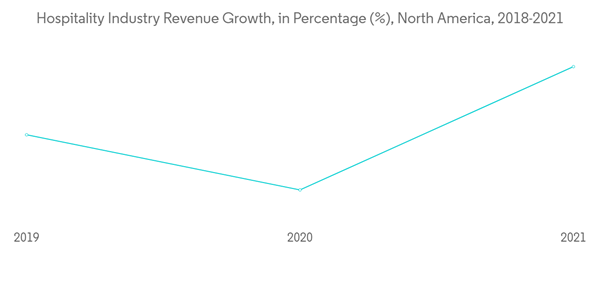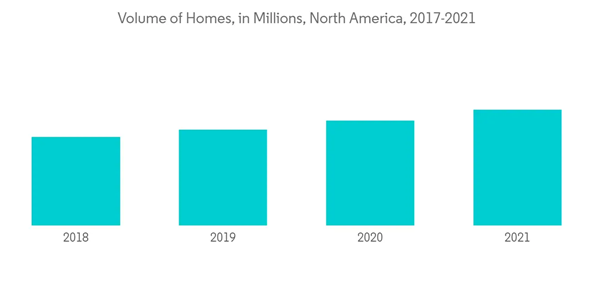The North America Modular Construction Market size is estimated at USD 33.99 billion in 2024, and is expected to reach USD 42.58 billion by 2029, growing at a CAGR of 4.61% during the forecast period (2024-2029).
The COVID-19 pandemic had a negative impact on the market in 2020. In the event of a pandemic, construction operations were temporarily halted during the lockdown, resulting in a reduction in modular construction work in various construction segments such as educational, residential, and airports, negatively impacting demand for the modular market.
The North American modular industry is currently made up of over 250 regional manufacturers building everything from construction site offices to single-family homes and hotels. The industry is regulated primarily at the state level through administrative agencies that implement and enforce the rules for building in that state. However, only 35 states (and one Canadian province) have such a program, meaning the remaining jurisdictions rely on local code officials to determine compliance and safety. Additionally, the programs lack a degree of uniformity in requirements and even terminology. For example, the program in Massachusetts is referred to as the 'manufactured buildings program,' while in other states, the industry is referred to as 'industrialized buildings,' or 'factory-built housing.'
The modular industry manufactured and labelled 2,041 multifamily units in 2019 or about 7.2% of total industry output. This figure is down slightly from 2018 indicating a shift of production into other markets such as hospitality. . Five states account for the majority of multifamily modular projects: California, Massachusetts, New York, New Jersey, and Pennsylvania, with modular projects reported in nine other states. Many hospitals and healthcare facility contractors are turning to modular, primarily for building components such as bathroom pods and headwalls. However, entire hospitals have been constructed utilizing modular construction techniques. For educational units, California, Georgia, New York, North Carolina, Texas, and South Carolina were the top states in terms of utilizing modular construction in 2019, accounting for 45% of total production. Historically, one of the key markets for the modular industry in Canada has been the industrial workforce housing sector. The modular industry provided temporary workforce housing solutions in remote regions where the energy sector was active. With the decline in oil prices in recent years, the industry has diversified into some of the above-mentioned markets more aggressively.
North America Modular Construction Market Trends
Hospitality Industry Driving the Market Growth
A shorter construction schedule means quicker occupancy for owners, and that means guests checking in months earlier than with conventional construction methods. Therefore, companies like Marriott Corporation have made modular construction part of their strategic plan. Cities such as New York are soon becoming home to some of the world's most ambitious modular hotels. The biggest hotel chain and well-recognized world luxury hotel brand -the International Marriott, is strategically expanding in North America based on modular construction. In the next few years, the company plans to build around 50 modular hotels in North America. AC Marriott plans to open the world's tallest modular hotel. A new 25-story AC Hotel by Marriott is planned at 842 Sixth Avenue, a very prestige location in Manhattan, New York City.
Due to the explosive interest and tremendous growth opportunities for the hotel and hospitality sector, the hospitality industry has been identified as a key market for the modular construction industry. The hospitality sector demonstrated the greatest growth in terms of number of units manufactured, from 1,487 units in 2018 to 1,955 in 2019. California was the strongest state for this market, followed by Kentucky, New Mexico, New York, and Texas.
Shortage of Skilled Labour and Housing Contributing to Market Growth
A shortage of skilled labor available for on-site work and increased pressure on project costs and schedules are primary reasons for the increasing popularity of off-site construction. In addition, improved technology allowing for greater applicability and customization, heightened concerns regarding safety and risk, and an increasing demand for higher quality were also stated as factors contributing to the growing interest in off-site approaches. Increasingly urgent demand in the housing, hospitality, and healthcare markets is also driving more projects to use modular construction. As many cities across the country are experiencing severe housing shortages, modular construction-with its potential to significantly increase the speed of delivery while also providing opportunities for cost savings-is seen as a strategy that's particularly well-suited to address the issue.
In the spring of 2018, the New York City Department of Housing Preservation and Development released a request for proposals for an affordable housing project in Brooklyn that requires modular construction methods. And according to Modular Building Institute, urban areas such as San Francisco, Seattle, and Vancouver are now considering modular construction as a means to address homelessness as well as to provide affordable housing for lower-and middle-income families.
North America Modular Construction Industry Overview
The North American modular construction market is highly fragmented, with no player holding a significant share to influence the market. Some of the key players in the North American modular construction market include ATCO Ltd, Katerra Inc., Mobile Modular Management Corporation, Boxx Modular (Black Diamond Group), and Aries Building Systems.
Additional Benefits:
- The market estimate (ME) sheet in Excel format
- 3 months of analyst support
This product will be delivered within 2 business days.










